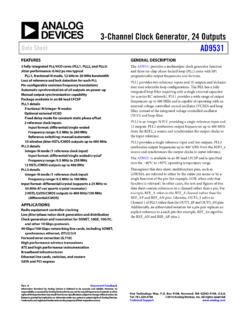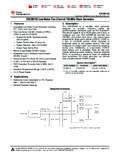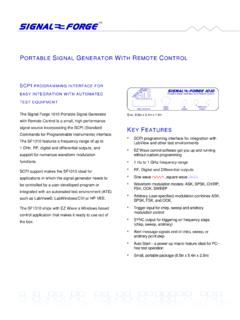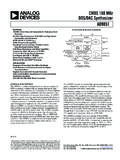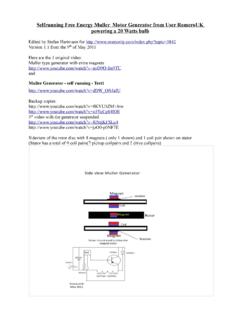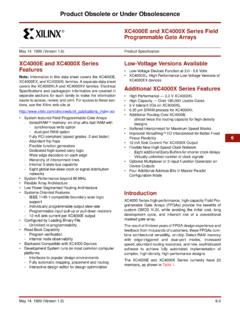Transcription of FIFO Generator v12 - Xilinx
1 fifo Generator IP Product GuideVivado Design SuitePG057 June 24, 2015 fifo Generator June 24, 2015 Table of ContentsIP FactsChapter 1: OverviewNative Interface FIFOs .. 5 AXI Interface FIFOs.. 6 Feature Summary.. 8 Applications .. 60 Licensing and Ordering Information .. 63 Chapter 2: Product SpecificationPerformance .. 64 Resource Utilization .. 64 Port Descriptions .. 78 Chapter 3: Designing with the CoreGeneral Design Guidelines .. 93 Initializing the fifo Generator .. 95 fifo Usage and Control .. 95 Clocking.. 120 Resets .. 125 Actual fifo Depth .. 133 Latency .. 135 Special Design Considerations .. 148 Chapter 4: Design Flow StepsCustomizing and Generating the Native Core .. 152 Customizing and Generating the AXI Core.
2 169 Constraining the Core .. 184 Simulation .. 184 Synthesis and Implementation .. 185 Chapter 5: Detailed Example DesignImplementing the Example Design .. 186 Send FeedbackFIFO Generator June 24, 2015 Simulating the Example Design.. 187 Chapter 6: Test BenchTest Bench Functionality .. 188 Customizing the Demonstration Test Bench .. 189 Messages and Warnings .. 190 Appendix A: Verification, Compliance, and InteroperabilitySimulation .. 191 Appendix B: DebuggingFinding Help on .. 192 Debug Tools .. 193 Simulation Debug.. 194 Hardware Debug .. 194 Interface Debug .. 195 Appendix C: Migrating and UpgradingMigrating to the Vivado Design Suite .. 196 Upgrading in the Vivado Design Suite.
3 196 Appendix D: dout Reset Value TimingAppendix E: fifo Generator FilesAppendix F: Supplemental InformationAppendix G: Additional Resources and Legal NoticesXilinx Resources .. 217 References .. 217 Revision History .. 218 Please Read: Important Legal Notices .. 219 Send FeedbackFIFO Generator June 24, 2015 Product SpecificationIntroductionThe Xilinx LogiCORE IP fifo Generator core is a fully verified first-in first-out ( fifo ) memory queue for applications requiring in-order storage and retrieval. The core provides an optimized solution for all fifo configurations and delivers maximum performance (up to 500 MHz) while utilizing minimum resources. Delivered through the Vivado Design Suite, you can customize the width, depth, status flags, memory type, and the write/read port aspect fifo Generator core supports Native interface FIFOs, AXI Memory Mapped interface FIFOs and AXI4-Stream interface FIFOs.
4 Native interface fifo cores are optimized for buffering, data width conversion and clock domain decoupling applications, providing ordered storage and Memory Mapped and AXI4-Stream interface FIFOs are derived from the Native interface fifo . Three AXI Memory Mapped interface styles are available: AXI4, AXI3 and more details on the features of each interface, see Feature Summary in Chapter FactsLogiCORE IP Facts TableCore SpecificsSupported Device Family(1) UltraScale Architecture, Zynq -7000, 7 SeriesSupported User InterfacesNative, AXI4-Stream, AXI4, AXI3, AXI4-LiteResourcesSee Table 2-2 through Ta b l e 2 - with CoreDesign FilesEncrypted RTLE xample DesignVHDLTe s t B e n c hVHDLC onstraints FileXDCS imulation ModelVerilog and VHDL Behavioral(2)Supported S/W DriverN/ATested Design Flows(4)Design EntryVivado Design SuiteSimulation(3)For other supported simulators, see the XilinxDesign Tools: Release Notes SynthesisSupportProvided by Xilinx @ : 1.
5 For a complete listing of supported devices, see the Vivado IP Behavioral models do not model synchronization delay. See Simulation in Chapter 4 for The fifo Generator core supports the UniSim simulation For the supported versions of the tools, see the Xilinx Design Tools: Release Notes FeedbackFIFO Generator June 24, 2015 Chapter 1 OverviewThe fifo Generator core is a fully verified first-in first-out memory queue for use in any application requiring ordered storage and retrieval, enabling high-performance and area-optimized designs. The core provides an optimized solution for all fifo configurations and delivers maximum performance (up to 500 MHz) while using minimum resources. This core supports Native interface FIFOs, AXI Memory Mapped interface FIFOs and AXI4-Stream interface FIFOs.
6 AXI Memory Mapped and AXI4-Stream interface FIFOs are derived from the Native interface fifo . Three AXI Memory Mapped interface styles are available: AXI4, AXI3 and core can be customized using the Vivado IP customizers in the IP catalog as a complete solution with control logic already implemented, including management of the read and write pointers and the generation of status :The Memory Mapped interface fifo and AXI4-Stream interface fifo are referred as "AXI fifo " throughout this Interface FIFOsThe Native interface fifo can be customized to utilize block RAM, distributed RAM or built-in fifo resources available in some FPGA families to create high-performance, area-optimized FPGA mode and First Word Fall Through are the two operating modes available for Native interface FeedbackFIFO Generator June 24, 2015 Chapter 1:OverviewAXI Interface FIFOsAXI interface FIFOs are derived from the Native interface fifo , as shown in Figure 1-2.
7 Three AXI memory mapped interface styles are available: AXI4, AXI3 and AXI4-Lite. In addition to applications supported by the Native interface fifo , AXI FIFOs can also be used in AXI System Bus and Point-to-Point high speed interface FIFOs do not support built-in fifo and Shift Register fifo the AXI FIFOs in the same applications supported by the Native Interface fifo when you need to connect to other AXI functions. AXI FIFOs can be integrated into a system by using the IP integrator. See the Vivado Design Suite User Guide: Designing IP Subsystems using IP Integrator (UG994) [Ref 5] for more Target - Figure 1-1 Figure 1-1:Native Interface FIFOs Signal DiagramGRXW>P @HPSW\UGBHQ:ULWH &ORFN 'RPDLQ5 HDG &ORFN 'RPDLQIXOOZUBHQGLQ>Q @DOPRVWBIXOO3 URJBIXOODOPRVWBHPSW\SURJBHPSW\YDOLGXQGHU IORZSURJBHPSW\BWKUHVKBDVVHUWVELWHUUGELWH UUZUBDFNRYHUIORZZUBGDWDBFRXQW>S @SURJBIXOOBWKUHVKBDVVHUWSURJBIXOOBWKUHVK BQHJDWHSURJBIXOOBWKUHVKLQMHFWVELWHUULQMH FWGELWHUUZUBUVWUVWUGBUVW237,21$/0$1'$725<237,21$/ 6,'(%$1'ZUBFONUGBFON5 HDG $JHQW:ULWH $JHQWUGBGDWDBFRXQW>T @SURJBHPSW\BWKUHVKBQHJDWHSURJBHPSW\BWKUH VKSend FeedbackFIFO Generator June 24, 2015 Chapter 1.)
8 OverviewThe AXI interface protocol uses a two-way valid and ready handshake mechanism. The information source uses the valid signal to show when valid data or control information is available on the channel. The information destination uses the ready signal to show when it can accept the data. Figure 1-3 shows an example timing diagram for write and read operations to the AXI4-Stream fifo , and Figure 1-4 shows an example timing diagram for write and read operations to the AXI memory mapped interface Target - Figure 1-2 Figure 1-2:AXI fifo DerivationX-Ref Target - Figure 1-3 Figure 1-3:AXI4-Stream fifo Timing Diagram s >/ LJ LJ y/ ^> s y/ D ^d ZtZ/d >K < KD /EZ >K < KD /E W Y LJ LJ D E dKZzKWd/KE > ^/ E y/ D ^d Z y/ ^> s y LJ Send FeedbackFIFO Generator June 24, 2015 Chapter 1:OverviewIn Figure 1-3 and Figure 1-4, the information source generates the valid signal to indicate when the data is available.
9 The destination generates the ready signal to indicate that it can accept the data, and transfer occurs only when both the valid and ready signals are AXI FIFOs are derived from Native interface FIFOs, much of the behavior is common between them. The ready signal is generated based on availability of space in the fifo and is held high to allow writes to the fifo . The ready signal is pulled Low only when there is no space in the fifo left to perform additional writes. The valid signal is generated based on availability of data in the fifo and is held High to allow reads to be performed from the fifo . The valid signal is pulled Low only when there is no data available to be read from the fifo . The information signals are mapped to the din and dout bus of Native interface FIFOs.
10 The width of the AXI fifo is determined by concatenating all of the information signals of the AXI interface. The information signals include all AXI signals except for the valid and ready handshake FIFOs operate only in First-Word Fall-Through mode. The First-Word Fall-Through (FWFT) feature provides the ability to look ahead to the next word available from the fifo without issuing a read operation. When data is available in the fifo , the first word falls through the fifo and appears automatically on the output data SummaryCommon Features Supports Native, AXI4-Stream, AXI4, AXI3 and AXI4-Lite interfaces fifo depths up to 131,072 wordsX-Ref Target - Figure 1-4 Figure 1-4:AXI Memory Mapped Interface fifo Timing DiagramSend FeedbackFIFO Generator June 24, 2015 Chapter 1.










